VVAM Newsletter 85 – 2002
Editors:
Drs. R.P.G.A. Voskuil
C. van Roekel
G.H. Maassen jr.
Newsletter No. 85, February 2002
Translated by Cathrien and Peter Clark
Representative in Great Britain: Niall Cherry, 3 Church Road, Warton, Lancs, PR4 1BD Tel. home 0177-2632764
Annual General Meeting
You are invited to attend the 22nd AGM / Annual Meeting of the Society of Friends of the Airborne Museum on Saturday 6 April 2002. The meeting will be held in the Zalencentrum Lebret, Lebretweg 51, Oosterbeek (tel. 026-3333168), starting at 10.30 hours.
The agenda is as follows:
1 Opening
2 Transfer of chairmanship
3 Minutes of the AGM of 7 April 2001
4 General report 2001
5 Financial report 2001
6 Budget for 2002
7 Audit Committee report
8 Appointment of reserve member to the Audit Committee
9 Questions
10 Closure of meeting
You will be given the General and Financial reports on arrival, and the Audit Committee report will be available for perusal at the hall entrance half an hour before the opening of the meeting. You can also request copies of the General and Financial reports by writing to the Treasurer, Mr F. Miedema, Woudstralaan 24, 6862 XE, Oosterbeek, enclosing a stamped (78 Eurocent stamp), self-addressed envelope.
During the AGM Chris van Roekel will step down as board member and chairman. He will be succeeded by Ben Kolster. It has been decided not to appoint a new member to the board this year.
After the AGM there will be a joint lunch followed by a visit to the Deelen Airfield Museum, cost; € 10,-. This amount should be paid to the SFAM Treasurer in Oosterbeek before 1 April. Those who intend going on the excursion will be given a lunch voucher on arrival at the hall.
You are kindly requested to organise your own transport to the Deelen Airfield Museum. Members without transport can notify E. Wijnhoud, tel. 026 3513100.
Events diary for 2002
The following events are to be organised in 2002: Friday 22 March: Meeting of SFAM members in the Airborne Museum with the aim of exchanging (historical) information and anything new. In short, social contact is the goal and ‘kick off’ is at 19.30 hours.
Saturday 6 April: AGM and afternoon excursion.
Saturday 13 and Sunday 14 April: Museum weekend and Perimeter walk.
Saturday 20 April: Market Garden 2 Excursion in co¬operation with the Documentation Group ’40 – ’45. Saturday 25 May: Book Fair.
29 May to 2 June: Excursion to Normandy, organised by the Airborne Museum.
Saturday 15 June: Walk along part of the Perimeter, organised by the SFAM.
25 August: Airborne Cycle Tour.
Saturday 7 September: 54th Airborne Walk.
Sunday 8 September: Lecture by Niall Cherry (further information to follow).
Friday 20, Saturday 21 and Sunday 22 September: Commemoration of the Battle of Arnhem.
Saturday 12 October: Bus excursion through the part of the Betuwe that played a major role during the Battle of Arnhem. Organised by the SFAM.
Saturday 26 October: Pegasus Walk, Lunteren- Renkum.
Saturday 2 November: Lecture by Marcel Zwarts about German vehicles at the Battle of Arnhem.
Exhibition
The ‘Market Garden in Miniature’ exhibition will be opened in the Airborne Museum on 19 April 2002. Over the years, Society member Guy DeLillio from the United States has made a great many 1 : 76 scale dioramas relating to operation Market Garden. During a preparatory visit to Oosterbeek by Mr DeLillio in June 2001, fourteen of these dioramas were selected and were shipped to the museum in January.
They were dismantled before sending and museum volunteer Theo Diepenbroek will reassemble them, making additions where necessary. For this Guy has sent a number of loose components, such as trees, soldiers etc. The dioramas will be set up in an original manner in the museum’s exhibition room. Items that are connected with the sites depicted by the dioramas will also be on display.
Photos of DeLillio’s work were published in the November issue of the British magazine ‘Military Modelling’, and some years ago photographs of his models were on show at the Imperial War Museum in London. The exhibition has been made possible by the co-sponsoring of the MBNA bank in America, who met a portion of the high transport costs. Guy DeLillio hopes to publish a book of photographs of his models to coincide with the exhibition, but the exact date of issue is not yet known.
The exhibition will run from 19 April to 3 November 2002 inclusive.
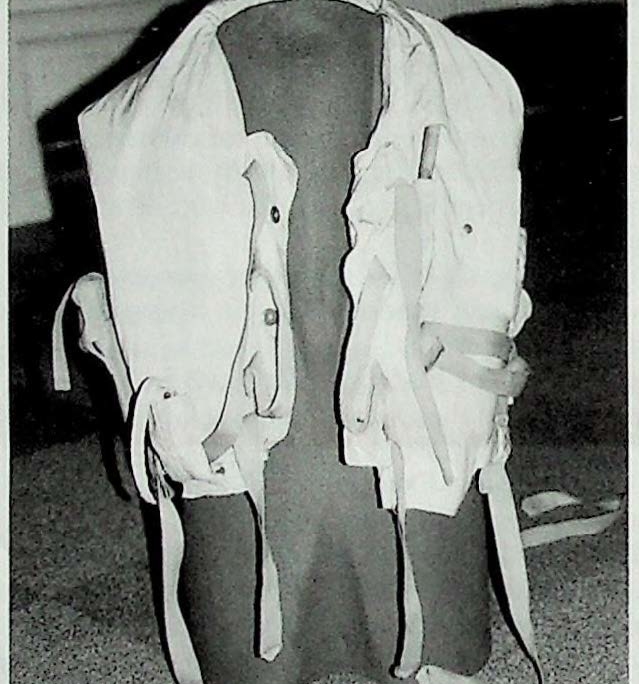 The ‘Mae West’ life jacket worn by Flight Engineer T. Haig during re-supply flights over Oosterbeek. (photo: Roland Bockhorst)
The ‘Mae West’ life jacket worn by Flight Engineer T. Haig during re-supply flights over Oosterbeek. (photo: Roland Bockhorst)
The story of a ‘Mae West’ life jacket
In September 1997, the Airborne Museum was given the ‘Mae West’ life jacket worn by Mr. T. Haig during the Battle of Arnhem when he flew as Flight Engineer with 620 Squadron RAF.
A number of aircraft from that squadron left for Arnhem from Fairford air base on 17 September 1944. One of these was machine no. EF 303, with the following crew: Pilot H.M. McLeod, Navigator R. Newton, Air Bomber H. Bate, Flight Engineer T. Haig, Radio Operator C.C. King, Air Gunner J.R. Thomas and two members of the Royal Army Service Corps.
Two days later the same crew flew on a re-supply mission to Arnhem in a different aircraft, LJ 830. They took off at 13.30 hours together with 35 other aircraft, returning to base at 18.10 hours.
The next mission took place on 21 September. L] 830 left at 18.10 hours on a re-supply flight to the Arnhem area, but failed to return.
Over Oosterbeek the aircraft was attacked by German Focke Wulf fighters and was also damaged by flak. The rear turret was hit and the rear gunner, J.R. Thomas, was thrown out. His body was found in an area west of Van Borsselenweg and north of Van der Molenallee: he was buried there in a field grave. He was later reinterred in the Airborne Cemetery in Oosterbeek (Plot 21.C.15). The Stirling came down in the vicinity of Renkum, the two Royal Army Service Corps soldiers being killed in the crash. These were probably S.L. Churchyard and J.F. Johnston.
The rest of the crew survived. McLeod and Bate were taken prisoner; Newton, King and Haig managed to find cover in the woods between Renkum and Wageningen. Next day they were discovered by a member of the Resistance, who helped them in escaping across the river with Operation Pegasus I. (Roland Boekhorst, maintenance staff)
Photograph of Stirling identified
It would appear from the following that even 57 years after the Battle of Arnhem, associated photographs can still be identified. For years one of our (board) members Cees van den Bosch has been involved (with others) in historical research into a Stirling bomber that crashed in the Planken Wambuis woods at Ede (see Ministory No. 57). He is also interested in the work of the so-called Air Despatchers of the Royal Army Service Corps, who were responsible for the actual dropping of the supplies from the air during the Battle.
All this time Cees had been searching diligently for a ground photo of the crashed machine. He knew of an aerial photo (see above-mentioned Ministory), but of course it showed no real detail.
Two years ago, during the preparation for the “‘Green On’, Air Despatchers, the forgotten heroes of Arnhem” exhibition in the Airborne Museum he saw a photo of the wreck of a Stirling. The caption referred to LJ 883, the subject of Cees’ research. However, the aircraft shown was lying ‘normally’ on its belly, whereas the aircraft in question ended up on its back following the crash-landing. At least, that was said by one of the two surviving crewmembers at that time, Flight Sergeant George Wood, tail gunner.
Cees drew attention to the incorrect caption and it was altered. However, the modified text also raised queries with the researcher, principally concerning the names of the Air Despatchers who died.
The first question was: which Stirling is actually shown in the photo in the Airborne Museum? The originally indicated location points emphatically to Planken Wambuis, and there is only one aircraft known to have come down in that area, LJ 883. Geert Maassen, Renkum municipal archivist had in his possession a series of photographs taken by a British army photographer on 18 April 1945 while on his way from Arnhem to Ede. One of these shows a Stirling wreck photographed from a slightly different position, but absolutely without doubt the same aircraft in the photo in the museum. And, just as in the other photograph, a field grave is also clearly visible, probably that of a member of the crew.
The next photo in the series shows the temporary military cemetery in an area north of the state highway to Ede and west of the Planken Wambuis Restaurant. It is known that the dead crewmembers from the above-mentioned aircraft, with one exception, were given their initial resting-place there. The previous photo in the series was taken a little to the east of the already mentioned restaurant.
Because the series therefore contains a clear line, we could assume that it was the aircraft wreck in (the vicinity of) the Planken Wambuis woods that was photographed.
Accurate study, using a stereoscope and other instruments, of the above mentioned aerial photo and from the subsequent series showed that an enormous shadow of the tail was visible. This would have been impossible if the machine was on its back! Also, partly in view of the angle of the light, Cees and co-editors Geert Maassen and Robert Voskuil concluded that the wreck shown in the two ground photos must (nevertheless) be that of LJ 883. Which means that George Wood had to be mistaken, not surprising when one considers the chaotic and dangerous situation he found himself in immediately after the crash. It also explains the single field grave, because, as written above, the crew was buried in the temporary cemetery with the exception of one man.
The conclusion of this story is that the aircraft in the two wartime photographs (one in the Airborne Museum and one in the Renkum Municipal Archive) is the Stirling with serial number LJ 883 (call sign V8K). The machine from 570 Squadron, Royal Air Force, was stationed at Harwell airfield in Berkshire at that time, and, with pilot Flying Officer William Kirkham at the controls, was one of 13 aircraft from the same unit scheduled to fly a re-supply mission to Arnhem on the Saturday afternoon of 23 September 1944. The outcome is known: the bomber was hit by flak and crashed. The following crewmembers were killed and were eventually buried in the Airborne Cemetery in Oosterbeek.
ASHTON, Harrold; Sergeant (Flight Engineer); RAF 1129447; 22 years of age; grave 4.A.14.
ATKINSON, David H.; Flying Officer (Air Bomber); RAF 133788; 23 years of age, grave 4.A.15.
BROWN, Ernest C.; Flying Officer (Air Bomber); RAF 173296; 20 years of age; grave 21.C.11.
HAND, Morris; Flying Officer (Navigator); RAF 138921; 26 yeas of age; grave 4.A.16.
KIRKHAM, William; Flying Officer (Pilot); RAF 174309; 21 years of age; grave 4.A.17.
REARDON, Gerard; Lance Corporal (Air Despatcher); T/185097; 31 years of age; grave 16.A.3. The survivors were: Flight Sergeant G. Wood (Ait- Gunner) and Air Despatcher S. Badham.
(Cees van den Bosch / Geert Maassen)
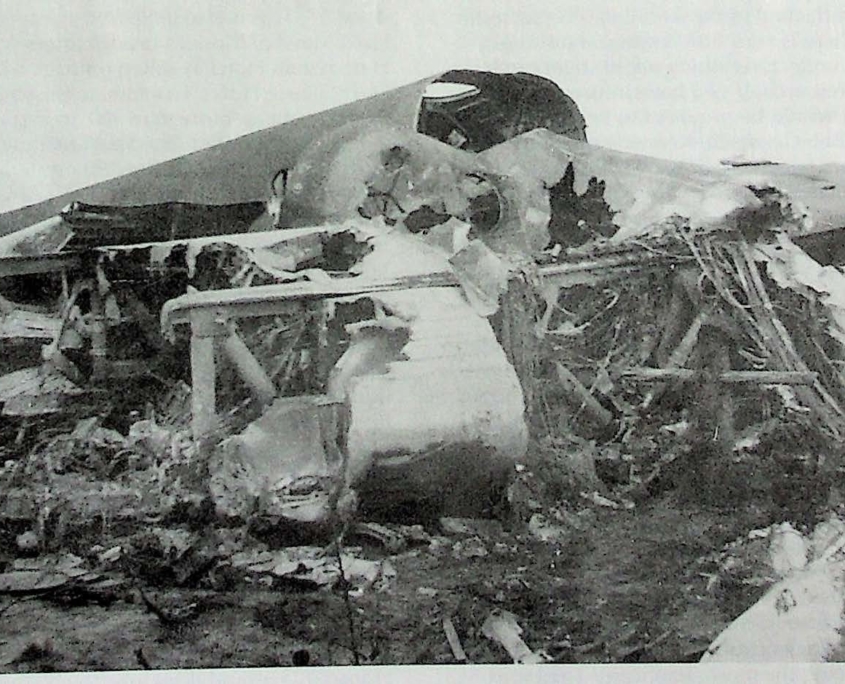
‘Arnhem in the Thirties’
Arnhem Municipal Archive has recently issued a CD-rom containing 71 photos from the 1930’s. These pictures are part of a collection of 136 glass negatives showing Arnhem street scenes, made between 1930 and 1940 and acquired not long ago by the Archive. The original principal was Uitgeverij Spaarnestad BV, publisher of illustrated magazines.
The photographs show the capital of Gelderland as it was just before the Second World War, a period wherein the Battle of Arnhem and subsequent acts of war would drastically alter the appearance of the city. The beautiful, ultra-sharp photographs are arranged per subject. Especially the pictures of the Rijnhotel, Onderlangs, the Old Harbour and the Rhine bridge give a good idea of the urbanisation that would have met the British Airborne troops when they entered the city on 17 September 1944.
The CD-rom is available from the Arnhem Municipal Archive, Westervoortsedijk 2, 6827 AS, Arnhem (telephone 026 3773650) and at the Airborne Museum. Price: € 10.
Appeal
How was the struggle at Arnhem reported in 1944, and who were the reporters? At the moment I am engaged in researching this subject.
As far as the British were concerned, reporting was the task of a ‘Public Relations Team’ consisting of photographers, film cameramen, BBC reporters and the written press.
The Germans had photographers, film cameramen and journalists attached to the so-called ‘Propaganda Kompanien’. There is very little known about the last-mentioned units. Everything about them can be of value to my research. If you have information on this subject and would be prepared to help me, please contact: Bob Gerritsen, Kennedystraat 4A, 6921 CW Duiven, telephone 0316-263743, e-mail: Bob.Gerritsen@icu.nl.
‘Arnhem’ by A.D. Harvey.
In October 2001, London publishers Cassell & Co introduced the series ‘Cassell’s Fields of Battle’ under the editorship of Richard Holmes. Holmes already has a number of books to his name and is best known in the Netherlands through the BBC TV series “War Walks”, the subject of one of the last in the series being ‘Arnhem’.
In an attempt to find something original to say, the author of the ‘Arnhem’ edition, A.D. Harvey, chose to describe the Battle of Arnhem through the eyes of the commanders. As expected, nothing new came to light. He suggests that the battle was lost mainly due to poor British leadership and to a combination of other factors, the lack of sufficient allied forces in the first few days being the most significant. The rapid German reaction to the landings made it impossible for the British to reinforce Frost’s unit at the Rhine bridge.
For most Dutch people these are not new revelations, perhaps indeed for some British folk. The first two chapters, in which Harvey discusses the concept and the planning, form the best part of the book. In the other chapters describing the progress of the battle, we come across a number of small errors. Sometimes even remarkable statements. A few examples: on page 50 it states that, according to General Urquhart, there were too few street maps of Arnhem available. Harvey says that the British only had the street maps that were given to them by civilians. This is not so, because the Airborne Museum archive and a number of collectors possess Arnhem street plans that were carried by the British troops and that were issued by the military authorities in England in 1944. On page 51 the author claims that the American Air Support Teams were insufficiently trained, his source for this assumption probably being the book ‘A Bridge Too Far’. The museum archive has a letter from one of members of this team that states they were well trained in the use of the type of radio set that was used at Arnhem.
The Germans allegedly shot three civilians near Ede for possession of pamphlets dropped by the Allies. Three civilians were indeed executed in Ede on 16 September 1944 in the woods opposite the Simon Stevinkazerne, but this had nothing to do with the possession of pamphlets.
According to Harvey the British reconnaissance unit was to advance along Amsterdamseweg to Arnhem (page 57). This is not correct: they followed the track alongside and to the north of the Ede-Arnhem railway line. The map on page 60/61 shows Landing Zone ‘Z’ as that of the 1st Airlanding Brigade, and that the Poles landed on 18 September on Landing Zone ‘L’. This is also incorrect.
Field Marshal Model’s headquarters was not in the Hartenstein Hotel as stated on page 64, but in DeTafelberg Hotel. To estimate the strength of Krafft’s unit at ‘more than 300′ men (page 68), is greatly exaggerated. The 1st Parachute Battalion under Dobie did not follow the route of the reconnaissance unit (page 68), but Amsterdamseweg. Contrary to this, the map on page 74 shows that the 1st Parachute Battalion advanced alongside the railway line. On page 75 we read the untrue story of the concrete bunker on the Arnhem Rhine bridge that, in this version, was even destroyed by 6 pounder anti-tank shells! General Urquhart’s sojourn in Zwarteweg in Arnhem is described with little regard for history. In this tale the general was hidden in a bedroom (page 94).
This is just a small selection from a huge number of errors. A shame, because the book provides a pacey read. With a little more care it could have been a much better book about Arnhem. If you buy the book read it with due reservation. In the meantime efforts are being made to have it for sale in the museum.
A.D. Harvey, ‘Arnhem’, Cassell & Co, Wellington House, 125 Strand, London 2001, ISBN 0-304-35699-9, 217 pages, illustrated, price £ 14,99. The price in euros is not yet known. (Wybo Boersma)

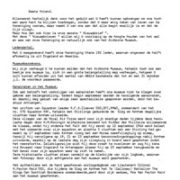
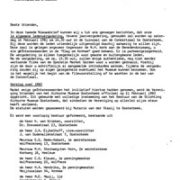
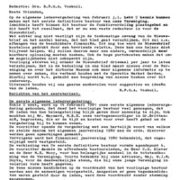
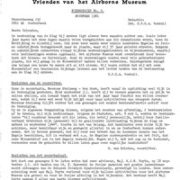
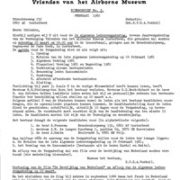
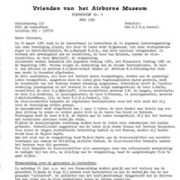
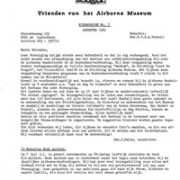
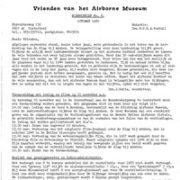
Plaats een Reactie
Vraag of reactie?Laat hier uw reactie achter.